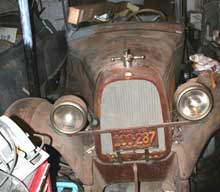The Overland car, volume seller from John North Willys‘s Willys-Overland Corporation, held a steady second place to Ford during the ‘teens, but sagged measurably in the early 1920s. So in 1926, Willys came up with an inexpensive car, the Whippet. Small and swift, like the canine whose name it bore, the Whippet caught on quickly, helped by the Model T’s old-age decline. It’s visual cue was a gently-rounded radiator shell, topped with a bounding dog mascot. Some cars were badged as Overlands, but most bore the Whippet emblem.
Body styles included coupe, coach and sedan, and sales of 253,000 cars, helped by prices as low as $610, pushed the make to third place in 1928. Power came from a 134 cubic inch L-head four, and later a six was added to the mix. The flagship sleeve-valve Willys-Knight continued in production, but drew few buyers.
In 1929, though, Hudson’s Essex nudged past Whippet for third place, and 1930 was no better. Total Willys-Overland sales sank below those of Pontiac and Oakland. For 1931, the Whippets gave way to Willys sixes and eights, but sales slipped to sixth, then tenth. For 1933, John Willys decided to concentrate on the low end of the market, and discontinued the large cars in favor of the Willys 77. In a time when the Terraplane was helping Hudson out of the doldrums, you’d think it might have been a tonic. Alas, sales fell still further, to 15th place, and stayed there for most of the thirties, despite updated models. The Whippet’s little four cylinder engine, though, went on to become a hero. Re-engineered and refined, it went on to power the immortal Jeep.

